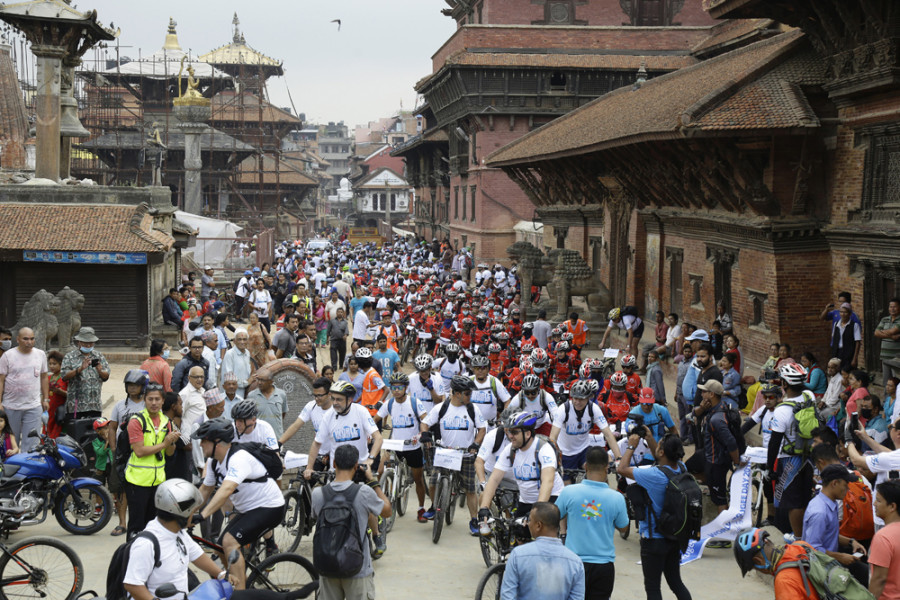Editorial
Lalitpur’s plan to make the city cycle-friendly should be lauded
But, as always, how the project is implemented is important.
One of the sad truths of modern urbanisation is that the roads and infrastructure have been built around cars. This idea of urbanisation and traffic has already begun to be challenged the world over. Yet, in a country like Nepal, problems associated with the mass use of private vehicles are still growing. What’s more, the use of motorcycles and scooters in a haphazard way, competing to find space between cars, has created a massive traffic burden. For years, the solution to the ever-growing problem has been to build more roads.
Read: Lalitpur Metropolitan City to start construction of 4.7 km cycle lane from next week
Taking off during Baburam Bhattarai’s tenure as prime minister in 2011, road expansion and lane development has been never-ending, and cyclical. Yet, this has only increased room for more cars and motorised two-wheelers to add to the traffic nightmare. As if all of this was not enough, the adoption of fossil fuel-powered vehicles en masse—coupled with the particulate matter-producing road development—has caused Kathmandu to be one the most polluted cities in the world. It is in this context that Lalitpur Mayor Chiribabu Maharjan’s plans to turn the artistic city cycle-friendly have been lauded. However, delays have put into question whether the scheme will ever be implemented. The onus is on Chiribabu and his administration to show the world how Nepal can lead in city redesign, and show the rest of the country the effectiveness of local governance.
Read: Patan wants to become a cycle city. But can it pull it off?
The plan, originally pitched in early 2019, revolved around inverting the mobility pyramid adhered to in the traditional urban planning model. So, instead of private vehicles receiving priority in road design, the new road would be centred around pedestrian and cyclist movement, followed by large public transport. In the first phase, the plan was to rid the core heritage route within Patan of all motorised vehicles, and build 100 cycle stands in 10 areas along the main road passing through Lalitpur. This was to be quickly followed by cycle-specific or cycle-prioritising lanes covering nearly 5 kilometres, from Kopundole to Lagankhel. The plan was commended by a public frustrated with the traffic and pollution—and with having to compete with vehicles to roam around their own neighbourhood.
Maharjan’s plan has a sound basis. He has consulted with urban planners and people-led modern urbanisation groups like the Nepal Cycle Society to work out the project. Like many cities in Europe, and unlike American or other Asian cities, many of Nepal’s metropolises are limited in population and the area covered. Without massive urban sprawl and with most people in the Valley commuting less than 6 kilometres, promoting cycle lanes and public transport over high-cost and infrastructure-intensive projects such as metro rails makes economic sense. Moreover, with vehicular emissions being a major contributor to the Valley’s air pollution, such a move may significantly improve air quality. And with Nepal vying for increased revenue from tourism, the idea behind making Patan vehicle-free will make it much easier for tourists and locals alike to enjoy the sights of that area. The simultaneous promotion of a walking heritage route in Patan does not seem coincidental.
Read: In chaotic Kathmandu, cycling is dangerous. Yet, thousands continue to do it
Yet, the project has been slow to start. For instance, the plan to build 100 bicycle stands should have been completed by mid-November. With four days remaining, only 37 stands in four locations have been built. The company contracted to build the stands has put the blame on the limited public space available. The land originally identified by Lalitpur to be used for bicycle stands was found to be part of the limited open space that locals used for other functions, such as recreation or Guthi-linked rituals and feasts. Obviously, the city’s vision for a people-centric vision would fail if it attempted to encroach on these open spaces. Alternatives need to be identified in haste.
***
What do you think?
Dear reader, we’d like to hear from you. We regularly publish letters to the editor on contemporary issues or direct responses to something the Post has recently published. Please send your letters to [email protected] with "Letter to the Editor" in the subject line. Please include your name, location, and a contact address so one of our editors can reach out to you.




 11.12°C Kathmandu
11.12°C Kathmandu












%20(1).jpg&w=300&height=200)

